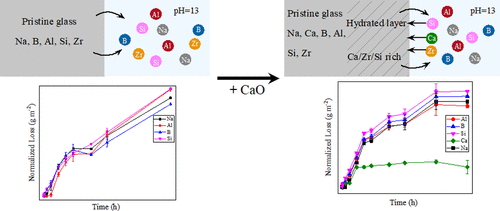当前位置:
X-MOL 学术
›
J. Phys. Chem. C
›
论文详情
Our official English website, www.x-mol.net, welcomes your
feedback! (Note: you will need to create a separate account there.)
Multiscale Investigation of the Mechanisms Controlling the Corrosion of Borosilicate Glasses in Hyper-Alkaline Media
The Journal of Physical Chemistry C ( IF 3.3 ) Pub Date : 2020-12-04 , DOI: 10.1021/acs.jpcc.0c08691 Fu Wang 1 , Nikhila Balasubramanya 1 , Qianhui Qin 1 , Randall E. Youngman 2 , Pinaki Mukherjee 3 , Nicholas Stone-Weiss 1 , Ashutosh Goel 1
The Journal of Physical Chemistry C ( IF 3.3 ) Pub Date : 2020-12-04 , DOI: 10.1021/acs.jpcc.0c08691 Fu Wang 1 , Nikhila Balasubramanya 1 , Qianhui Qin 1 , Randall E. Youngman 2 , Pinaki Mukherjee 3 , Nicholas Stone-Weiss 1 , Ashutosh Goel 1
Affiliation

|
The overarching goal of the present multiscale investigation is to unearth the kinetics and mechanisms of corrosion of borosilicate glasses in hyper-alkaline (pH = 13) environments as a function of their chemical composition. Accordingly, a series of 3- to 6-component borosilicate glasses have been designed starting from Na2O–B2O3–SiO2 ternary, wherein the compositional complexity has been added in a systematic tiered approach, finally resulting in the composition of the well-known international simple glass (ISG). Tetramethylammonium hydroxide (TMAH), one of the most widely used alkaline etchant in the glass and electronics industry, has been used as the corrosion media. A series of state-of-the-art characterization techniques including magic angle spinning nuclear magnetic resonance spectroscopy, X-ray photoelectron spectroscopy, inductively coupled plasma optical emission spectroscopy, elastic recoil detection analysis, and high-resolution transmission electron microscopy have been employed to unearth the compositional dependence of glass corrosion in hyper-alkaline environments. The glass compositions underwent congruent corrosion in the forward rate regime, whereas the controlling mechanism of corrosion in the residual rate regime depends on the presence/absence of Ca in the surrounding environment and can be explained on the basis of the dissolution–reprecipitation model. The dependence of corrosion kinetics and the chemistry of alteration products (in the residual rate regime) on the glass composition have been discussed. The results presented in this contribution will ultimately supplement the scientific literature attempting to understand the fundamental science governing the aqueous corrosion of silicate-based glass chemistries and add to the growing database required to develop nonempirical predictive models for designing glasses with controlled dissolution rates.
中文翻译:

控制高碱性介质中硼硅酸盐玻璃腐蚀机理的多尺度研究
本多尺度研究的总体目标是揭示高碱性(pH = 13)环境中硼硅酸盐玻璃腐蚀的动力学和机理,作为其化学成分的函数。因此,从Na 2 O–B 2 O 3 –SiO 2开始设计了一系列3至6成分的硼硅酸盐玻璃。三元玻璃,其中成分的复杂性已通过系统的分层方法增加,最终导致了众所周知的国际简单玻璃(ISG)的成分。四甲基氢氧化铵(TMAH)是玻璃和电子工业中使用最广泛的碱性蚀刻剂之一,已被用作腐蚀介质。包括魔角旋转核磁共振波谱,X射线光电子能谱,感应耦合等离子体发射光谱,弹性反冲检测分析和高分辨率透射电子显微镜在内的一系列最先进的表征技术已被用于揭示了在高碱性环境中玻璃腐蚀的成分依赖性。玻璃组合物在前进速率范围内经历了全腐蚀,而残留率范围内腐蚀的控制机制取决于周围环境中钙的存在与否,可以根据溶解-再沉淀模型来解释。讨论了腐蚀动力学和蚀变产物的化学性质(在残留速率范围内)对玻璃成分的依赖性。该贡献中提供的结果最终将补充试图理解控制硅酸盐基玻璃化学物质水腐蚀的基础科学的科学文献,并增加为开发用于设计可溶速率受控的玻璃的非经验性预测模型所需的不断增长的数据库。
更新日期:2020-12-17
中文翻译:

控制高碱性介质中硼硅酸盐玻璃腐蚀机理的多尺度研究
本多尺度研究的总体目标是揭示高碱性(pH = 13)环境中硼硅酸盐玻璃腐蚀的动力学和机理,作为其化学成分的函数。因此,从Na 2 O–B 2 O 3 –SiO 2开始设计了一系列3至6成分的硼硅酸盐玻璃。三元玻璃,其中成分的复杂性已通过系统的分层方法增加,最终导致了众所周知的国际简单玻璃(ISG)的成分。四甲基氢氧化铵(TMAH)是玻璃和电子工业中使用最广泛的碱性蚀刻剂之一,已被用作腐蚀介质。包括魔角旋转核磁共振波谱,X射线光电子能谱,感应耦合等离子体发射光谱,弹性反冲检测分析和高分辨率透射电子显微镜在内的一系列最先进的表征技术已被用于揭示了在高碱性环境中玻璃腐蚀的成分依赖性。玻璃组合物在前进速率范围内经历了全腐蚀,而残留率范围内腐蚀的控制机制取决于周围环境中钙的存在与否,可以根据溶解-再沉淀模型来解释。讨论了腐蚀动力学和蚀变产物的化学性质(在残留速率范围内)对玻璃成分的依赖性。该贡献中提供的结果最终将补充试图理解控制硅酸盐基玻璃化学物质水腐蚀的基础科学的科学文献,并增加为开发用于设计可溶速率受控的玻璃的非经验性预测模型所需的不断增长的数据库。











































 京公网安备 11010802027423号
京公网安备 11010802027423号